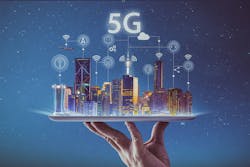Download this article in .PDF format.
5G: Are we there yet?
In 2019, hype meets reality for 5G devices and services. After several years of discussions on use cases and exotic technologies, “real” 5G products will start to scale on 3GPP Release 15 5G NR networks. On the use-case front, the focus will be on enhanced mobile broadband (eMMB) with both fixed and mobile 5G wireless services becoming available to more consumers. The much talked-about ultra-reliable low latency communications (URLLC) corner of the 5G use-case triangle will continue to aspire to deliver unique capability as 3GPP Release 16 marches along toward adoption.
5G in 2019 is all about delivering a bigger, fatter data pipe for our mobile devices, as the insatiable consumption of data (primarily driven by video) is predicted to grow by a factor of nearly seven times between now and 20241. While 5G is casually talked about as a specific technology, and of course it does have a technology component, we should not forget that 5G was originally conceived as a harmonious interworking of multiple technologies forming a configurable network. A crucial component to this is 4G LTE, which provides the anchoring launch point for 3GPP 5G non-standalone (NSA) networks. Additionally, Wi-Fi will be the primary method in which many users will directly interact with 5G in 2019. Some initial deployments of 5G require a “technology translator” to convert 5G signals to something that our existing devices can use… hello Wi-Fi!
Let’s talk 5G devices
We had some exciting 5G product announcements in 2018—and it continued already in 2019 at the Consumer Electronics Show in January and will at Mobile World Congress (Barcelona) as device makers and wireless service providers reveal additional detail on their near-term 5G deployment plans. We are starting to see mobile 5G products in the form of mobile hotspots (also called “pocket routers”) as well as sleek smartphone concepts that incorporate millimeter-wave 5G technology. The innovation of the 5G mobile form factor has advanced at a surprising pace, when you compare it to the clunky 5G tablets demonstrated at the Korean Olympics earlier in 2018.
Sometimes, technology advancements are like a dog chasing its tail. The deployment of 5G hotspots, for example, opens up the possibility of streaming incredibly fast (up to Gbps) data rates to other devices. However, on the other side of that 5G hotspot, you don’t want a legacy Wi-Fi technology choking the effective speed on the user’s side. A new Wi-Fi technology (IEEE: 802.11ax), recently branded as “Wi-Fi 6” by the Wi-Fi Alliance, is on its way to help make sure that this bottleneck doesn’t happen. Fundamentally, Wi-Fi 6 not only enables fast data speeds, but it also enables simultaneous, high-bandwidth operation to multiple users, making it ideal for hotspot applications.
A dirty little secret about previous generations of Wi-Fi is that all communication is implemented in an entirely serial fashion. The bandwidth in Wi-Fi 5 (and earlier generations) is divided by the number of users in the network. This means that that you have to wait your turn in line, making it problematic in a crowded environment when you REALLY want to watch that cat video. This is the reason why you have probably experienced poor wireless connectivity at an airport. Expect many mobile device companies to announce products incorporating Wi-Fi 6 technology in 2019.
As consumers, we have been hypnotized by “better, faster, cheaper” when it comes to new electronic gadgets. However, with 5G, (particularly incorporating the new millimeter-wave technology) the consumer might be in for a bit of a shock. Recently, a prominent smartphone maker stated that they expect 5G to add $200-$300 to the price of the phone2. Then, there’s the data plan. In a recent service announcement, a major U.S. wireless carrier set expectations for a 5G plan at $70 per month for 15GB of data3, a premium over today’s 4G unlimited plans.
5G test technology implications
The 2019 deployments of 5G technology will be premium devices and services. One of the reasons for this is that commercializing some of the “exotic” technologies used in 5G requires some radical cost reduction in order to deliver to the masses. In manufacturing, new techniques and equipment are required. For example, it is common that millimeter-wave test equipment is a rack of expensive equipment that needs to be strapped together with multiple, interconnecting cables, remote frequency converters, and is an exercise for the advanced-placement student to calibrate and glue together with software. Even if larger volumes can bring the cost of such a solution down, it just isn’t a scalable and reliable solution for the manufacturing environment. Scaling to volume requires that the equipment is accurate, reliable, and easy to set up and operate on the manufacturing floor.
Additionally, scaling 5G to the masses requires a major innovation in measurement methodology. Specifically, calibrating and validating the unique transmission of millimeter-wave signals in a 5G product requires measuring the signal from the antenna with no direct connection between the tester and the device to be tested. We refer to this as over-the-air (or OTA) testing.
Ironically, even though no physical connection is made, an OTA measurement setup requires a significant amount of expensive “stuff” (high-end cables, measurement antennas, waveguide connections, etc.) that can make measurement setups quite expensive. 5G devices have multiple, directional antennas, and a typical millimeter-wave horn antenna can cost several thousand dollars. If a measurement setup requires multiple antennas, the costs add up quickly. Optimizing a 5G OTA measurement setup requires balancing the physical size and number of measurement antennas in the system, as well as minimizing the amount of manufacturing operator interaction. In manufacturing, every “test insertion” or physical movement of the device costs money.
Waiter, I’d like the 5G with Wi-Fi on the side
2019 will be like a glimpse at the future of wireless networking through a somewhat smudgy window. We will be able to touch and feel real devices and services, but expect both the use-cases and business models to evolve. There are still spectrum auction hurdles to get through, as well as massive network equipment build-outs that need to happen. Building out an outdoor 5G network appears to be quite feasible. The trouble is that the majority of data is actually consumed indoors! 5G will need to employ a combination of “5G-to-Wi-Fi translators” as well as indoor small cells in order to gain adoption.
As mentioned, in the early stages of the rollout, many mobile devices won’t directly interface with 5G signals, but rather will talk to the 5G network over Wi-Fi. Devices that enable this are currently going by several names: 5G hotspots, fixed wireless terminals, pocket routers, customer premise equipment, etc. No matter what the name is, the use-model is similar and Wi-Fi performance becomes extremely noticeable. With the wide-area bottleneck opening up, more attention will be spent on delivering high-speed Wi-Fi.
Specific to test and measurement, there are a few key areas of emphasis in Wi-Fi 6 devices. Of note, power control and timing are key characteristics to validate. Like 4G cellular networks, Wi-Fi 6 employs a multi-user technology called “OFDMA” which enables many users to operate at the same time, but requires strict rules on how much power to transmit as well as when to transmit. In this type of ecosystem, one “rogue” device not only will experience bad performance, but it has the ability to interfere with other users that are using the network. As with all things related to test, though, it is a balancing act of ensuring quality and the cost of testing (usually dictated by test time duration). New innovations in test methodology will be deployed to enable additional test coverage without paying a high penalty in test time.
I’m in it for the long haul
As we continue through the journey into the 5G era, there will be milestones, but it is still difficult to see the final destination. Last year brought major technical leaps in mobile device engineering. Technical feasibility has been proven, but we still have a way to go. We no longer have to imagine that 5G can be put into a smartphone form factor, but there are still areas to innovate to make this truly a technology for the masses.Adam Smith is director of product marketing at LitePoint, where he is in charge of managing products from launch and through their life cycle. He previously was business development manager for Verigy, a division of Advantest, and also product manager at Credence Systems Corp. He started his career as an applications engineer at Teradyne.
References:
1. Ericson Mobility Report, November 2018.
2. TheVerge.com, “5G phones could cost $200 to $300 more, says OnePlus CEO,” Dec. 5, 2018.
3. Axios.com, “AT&T to launch 5G mobile service on Friday,” Dec. 18, 2018.



